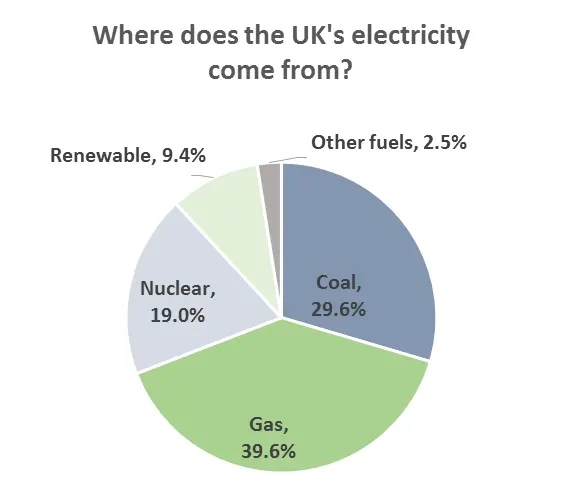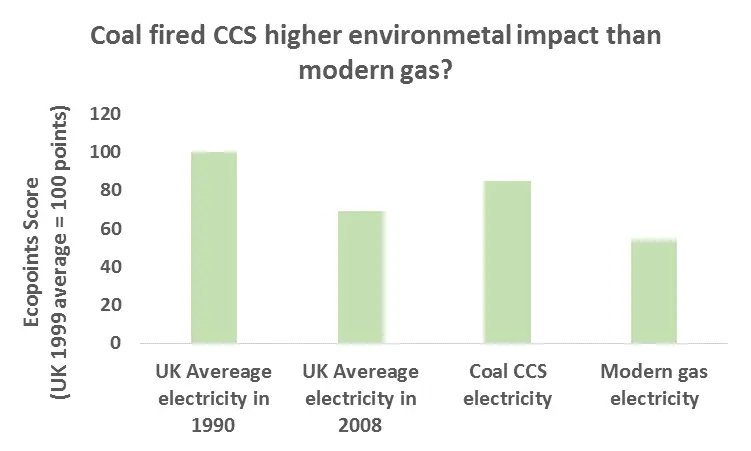Blog, Carbon Footprint, Energy, News
Carbon capture and storage (CCS) electricity revealed to be high environmental impact
The UK is legally committed to reducing greenhouse gas (GHG) emissions by 80% between 1990 and 2050. This is a considerable challenge and all sectors have a valuable part to play. To be achieved the electricity sector is expected to have an almost complete decarbonisation and it’s clear to see why. Electricity generation contributes around 30% to the UKs GHG emissions and being a highly centralised system it’s an obvious target for reduction.
However, future electricity demand is predicted to rise from an increasing population, higher demand for electric vehicles and heat pumps, and from a future tipping point that could facilitate a ‘dash for electricity’ – at the point when electricity becomes lower carbon than using natural gas. As a result the carbon footprint of each kilowatt hour of electricity needs to reduce 95% by 2050. That said, the Committee on Climate Change consider the decarbonisation of electricity as the most cost effective strategy to meeting the UK carbon budgets.
To achieve such a challenging target the UK needs to rely on a mixture of proven low carbon generation technologies such as nuclear, wind, solar and biomass. But we also have considerable hopes pinned on the development of carbon capture and storage (CCS) technologies. CCS is often expected to capture 90% of the GHG emissions from coal and gas fired generators. But what are the implications of this, and will carbon capture and storage really allow us to meet a 90% reduction in our GHG emissions?
Let’s start by looking at our current supply of electricity. In 2011 gas provided 40% of our electricity generation, coal 30%, nuclear 19%, renewable 9.4% and other fuels provided 2.5%. Natural gas and coal therefore provided 70% of our electricity needs. It’s therefore clear to see why so many hopes are pinned on the success of carbon capture and storage technologies.
Carbon Capture and Storage (CCS) can’t deliver as promised
However, just as prominent was the fuel penalty of a CCS installation, which is often considered to be around 15-20 % (extra fuel requirement). This adds further to the lower generation efficiency of coal fired electricity, which in turn increases upstream methane emissions. In fact, when upstream emissions are also considered carbon capture and storage may only deliver a 70 % reduction in GHG emissions for coal fired generation. Currently, coal-fired electricity was found to release 1.09 kg CO2e per kWh of electricity delivered to the UK consumer. This was predicted to fall to 0.31 kg CO2e per kWh with CCS technologies. This is far short from the hopes of a 90 % GHG reduction.
For comparison gas fired CCS generation was found to offer an 83% reduction in GHG emissions on a whole life basis. Gas-fired electricity currently releases 0.47 kg CO2e per kWh of electricity delivered to the UK consumer. This was predicted to fall to 0.08 kg CO2e per kWh with CCS technologies. Whilst the results for gas are more promising it should be noted that with depleting North Sea gas reserves the UK is looking abroad to provide more and more of its fossil fuels. This requires longer transport distances and longer gas pipelines, which in turn gives rise to more fugitive methane emissions for gas and its resulting GHG impact.
Wider Environmental Impacts of Carbon Capture and Storage
Coal fired carbon capture and storage (CCS) has a higher impact than current gas fired electricity?
However, the most striking result using this approach was that coal fired CCS is predicted to have a higher environmental impact than current gas fired generation – 85 ecopoints for Coal CCS to 54 ecopoints for current gas fired generation. This is significant and some of the key issues were increased depletion of fossil fuel reserves, human toxicity impacts and of course carbon footprint. It’s also interesting to see that current gas fired generation has a carbon footprint of 0.47 kg CO2e per kWh in comparison to coal CCS at 0.31 kg CO2e per kWh, which is just 35% lower than current gas generation. These results compare with the ecopoint score of average electricity in 2008 of 69 ecopoints.
These results don’t look particularly promising for coal CCS from an environmental sustainability perspective, which is even higher environmental impact than the UK average electricity from 2008. This is unfortunate as coal is expected to become the world’s top energy source by 2017.
So what can we take from such analysis and what should we do about it? If we are to rely on carbon capture and storage as a future technology that will help us meet an 80% reduction in GHG emissions then we have to be careful that we don’t increase emissions elsewhere in the supply chain and that we don’t burden shift. We should be looking closer at fugitive methane emissions in coal mining and gas transmission and distribution. But we should also be asking what does coal CCS need to do to become a more attractive environmental proposition? To reduce the carbon footprint, and wider environmental impacts, of coal fired CCS will require considerable advances in the electrical efficiency of coal fired generators. Without such advances coal fired carbon capture and storage won’t offer as much environmental benefit as it first appears.
But this still leaves the question will coal fired CCS be able to offer any environmental gain? Please share your valuable opinion…
This article was originally published in Energy World (Energy Institute).
If you like this post please consider sharing it on social media using the buttons below, signing up to our Newsletter to receive future blogs by email, or by following Craig on Twitter, or LinkedIn .
Reference to original journal paper: “The energy and environmental implications of UK more electric transition pathways: A whole systems perspective”, Energy Policy 52 (Jan 2013), pg 103–116, http://dx.doi.org/10.1016/j.enpol.2012.08.071


